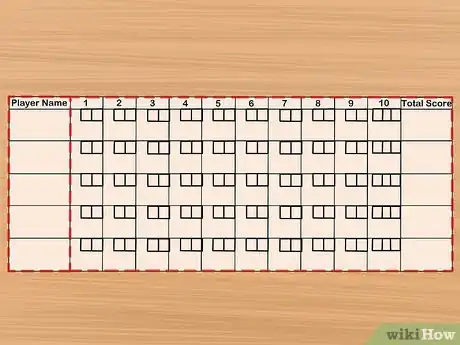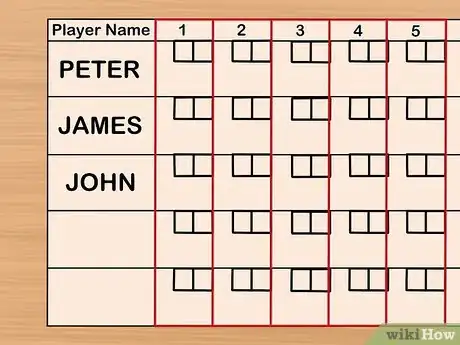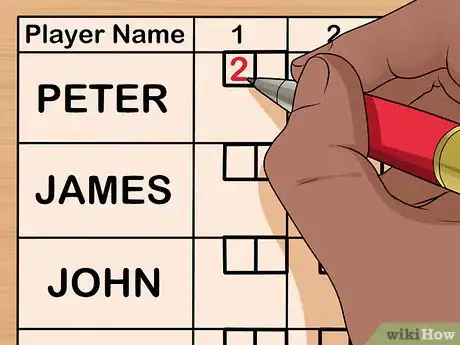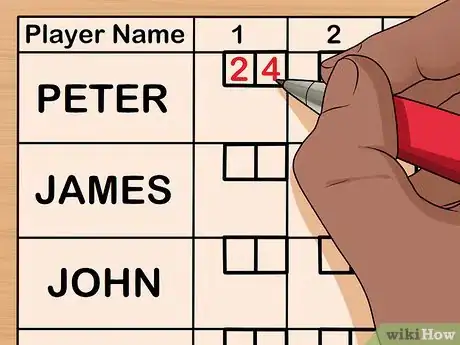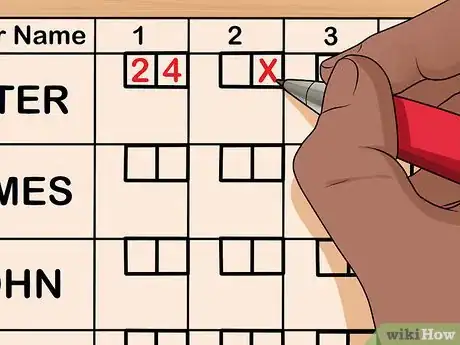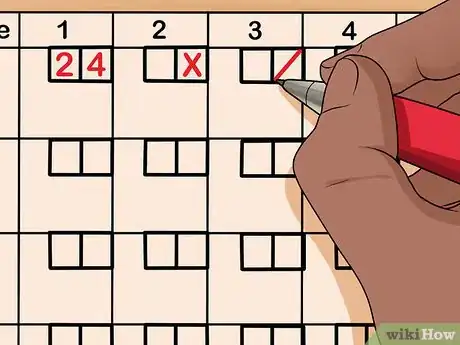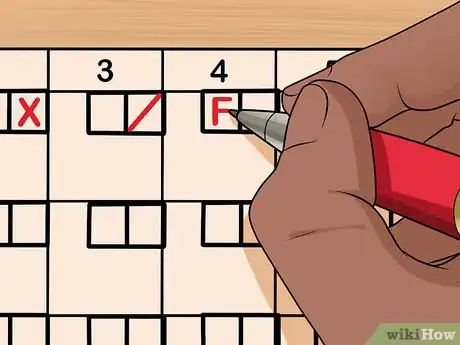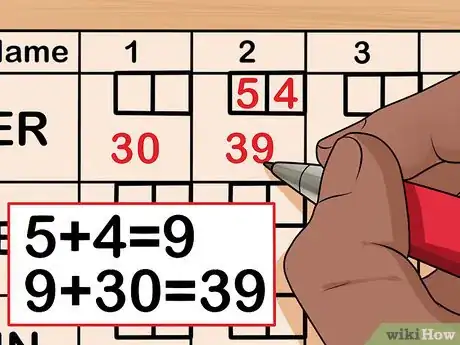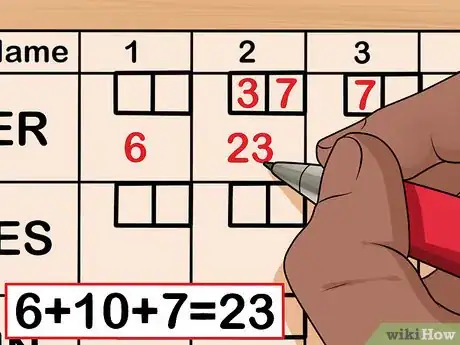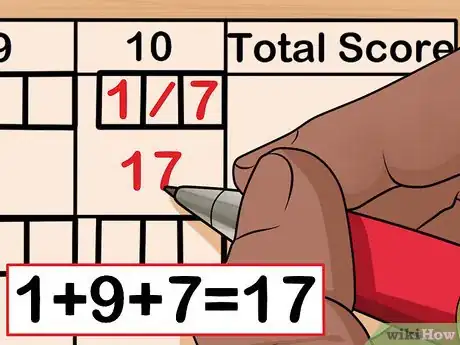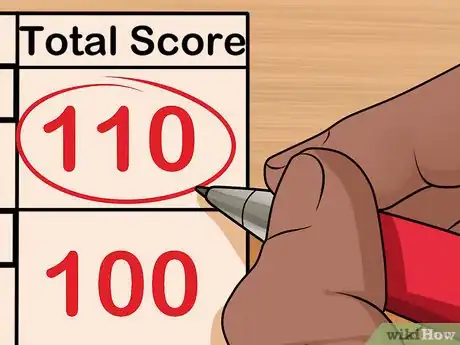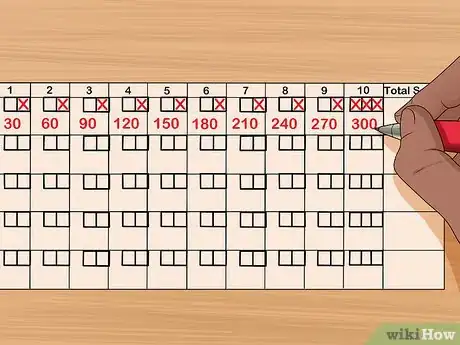This article was co-authored by wikiHow staff writer, Megaera Lorenz, PhD. Megaera Lorenz is an Egyptologist and Writer with over 20 years of experience in public education. In 2017, she graduated with her PhD in Egyptology from The University of Chicago, where she served for several years as a content advisor and program facilitator for the Oriental Institute Museum’s Public Education office. She has also developed and taught Egyptology courses at The University of Chicago and Loyola University Chicago.
wikiHow marks an article as reader-approved once it receives enough positive feedback. In this case, several readers have written to tell us that this article was helpful to them, earning it our reader-approved status.
This article has been viewed 351,544 times.
Learn more...
Most modern bowling alleys are set up for electronic scoring, but understanding how to score bowling is important when electronic scoring is not available. To make sure you're keeping score correctly, you'll first need to practice scoring individual frames. Then, as you go, add up those frames so you know your final score at the end of the game. Keep in mind that some pinfalls, like spares and strikes, have their own special scoring rules.
Steps
Scoring Individual Frames
-
1Understand the parts of the bowling scorecard. On the far-left edge of the bowing scorecard is a column of empty spaces where you can write the names of each player who is participating in the game. To the right of the names are 10 scorecard frames. Each frame is used to total the score of a single turn frame.
Note: There may be a list of numbers to the left of the spaces where you’re meant to write the player names. These numbers do not affect the way you score the bowling game.
-
2Use the scorecard frame that corresponds to the turn you’re taking. Above each column of scorecard frames is a number. These numbers proceed from left to right, starting with “1” and rising to “10.” Tally each player’s score within the scorecard that matches the frame they are bowling. For instance, on your first turn, use the first scorecard frame. On your fifth turn, use the fifth scorecard frame, and so on.Advertisement
-
3Write the score for the first roll in the upper left box for that turn. Each player gets to bowl twice in each turn except in the last (tenth) frame unless they get all the pins down with their first ball. Each player will bowl a maximum of 21 times per game. It's important that you record each of these rolls individually, so record the number of pins you knock down on your first roll in the upper left box.
- For instance, if you knock over 2 pins on your first roll, write the numeral “2” in the upper left box.
-
4Write the second roll's score in the upper right-hand box for that turn. After you've rolled for the second time, add that number to your scorecard. Make sure you only write down the number of pins you knocked down in your second roll, not the total number of pins you knocked down for the turn.[1]
- For example, if you knocked over 4 pins on your second roll (and 2 pins on your first roll), you'd write the number "4" in the upper right-hand corner, not the number "6."
-
5Write an “X” in the small box in the top-right of the scorecard frame to indicate a strike. A strike indicates that you knocked down all 10 pins in your first roll. While the small box in the top-right of the scorecard frame is typically reserved for scoring information that relates to the second roll of your turn, scoring rules make an exception for the strike.[2]
-
6Place a forward slash in the small box in the top-right corner of the scorecard frame to indicate a spare. A forward slash (a line connecting the bottom left corner to the upper right corner of the box in the upper right) indicates that you didn’t knock down all the pins on your first roll, but you did on your second roll.[3]
- Make sure to indicate how many pins you have knocked over in the first roll in the upper-center box. For example, if you knocked down 3 pins on your first roll and 7 pins on the second roll, write a “3” in the box in the upper center and a forward slash in the smaller box on the upper right.
-
7Mark a foul by writing an “F.” If you step past the foul line (the line beyond which a bowler cannot step) on your first roll for that turn, place an “F” in the upper center box. If you step past the foul line on your second roll for that turn, place an “F” inside the small box in the upper right of the scorecard frame.
- You’re still allowed a second roll if you foul on your first roll of the turn.
-
8Mark the scorecard with a dash if you miss the pins. If your ball goes in the gutter or if you otherwise miss the pins, indicate the miss with a horizontal dash (-). For instance, if your ball went in the gutter on your first roll, you’d mark a dash in the small box in the top-center of the scorecard frame. If your ball went in the gutter on your second roll, you’d mark a dash in the small box to the upper right of the scorecard frame.[4]
- If you miss the pins on one roll but knock some of them over on the other, make sure to record the score for the roll where you did knock some pins over.
Tallying Your Score Between Turns
-
1Add the total number of pins knocked down in your 2 rolls when your turn is complete. For instance, if your current score is 30 and the numbers at the top of the scorecard frame you just completed are 5 and 4, you’d add 9 (5+4) to 30. Your current score would then be 39.[5]
- Write your current score in the bottom of the scorecard frame, beneath the numbers for the turn you just completed.
-
2Score a spare by adding 10 to the number of pins knocked down on the next roll. A spare occurs when you knock down the remaining pins on the second roll of your turn. For instance, if you knock down 1 pin on your first roll and 9 pins on your second roll, you’ve scored a spare. A spare can be worth anywhere from 10 to 20 points depending on how much you score in the next roll. In order to get the maximum number of points, you’d have to make a strike on your next roll. [6]
- When you get a spare, wait to calculate the score for that turn until you roll your first roll for your next turn. Then, write that score in your previous turn's frame.
- For example, let's say you're bowling in turn 2 and you scored 6 points in turn 1. In turn 2, you roll a 3 on your first turn and a 7 on your second. You've rolled a spare! Instead of adding up 3+7 to get 10 (for that turn) and adding it to 6 from your previous turn, wait until you've rolled the first roll of turn 3. If you roll a 7, you then add up 6 (your turn 1 score)+10 (your spare)+7 (your first roll of turn 3) to get 23!
- Note that you still add up your rolls for turn 3. If you rolled a 7 and then a 2, you'd add 23 (your score in turn 2)+9 to get 32 for turn 3.
-
3Score a strike by adding 10 to the sum of the next turn. A strike is when you knock down all of the pins on your first roll for that turn. A strike’s worth can be anywhere from 10 to 30 points, depending on how you roll after the initial strike.[7]
- When you get a strike, wait to calculate the score for that turn until you've completely finished the next turn.
- For instance, let's say you get a strike in turn 1. In turn 2, you roll a 2 and a 6, for a total of 8 points. Once you finish turn 2, your score for turn 1 is 18: 10 (for the strike)+8 (in turn 2). Write the number "18" in the main square in your scorecard frame for turn 1. Then, add 18+8 for a total of 26, and write the number "26" in the main square in your scorecard frame for turn 2.
- Note that, if you miss all 10 pins on the 1st roll of your turn and then knock all 10 down on the second roll, it's still considered a spare, not a strike.
Calculating Your Final Score
-
1Only use the upper-right corner box in the 10th turn if you roll a spare or a strike. The third box in the 10th turn is known as the "fill box," which helps decide what your spare or strike will be worth if you roll one in the 10th turn.[8]
- For instance, if you knock down 1 pin in your first roll and 9 pins in your second roll, you’d write “1” in the small box furthest to the left and a “/” in the top-center box. Then, you'd bowl once more. Add the number you roll to 10 to calculate your spare. For example, if you rolled a 7 on your third roll in the 10th turn, you'd add 1+9 (to calculate the spare)+7, for a total of 17 for that turn.
- Alternatively, if you roll a strike on your first roll of the 10th turn, roll twice more. If you roll an 8 and then a 1 (for a total of 9), your score for that turn is 19.
- If you do score a spare or a strike in the 10th turn, tally the total from left to right.
-
2Determine the winner by comparing the final score of the 10th frame. For instance, if your 10th-frame score is 110 and your friend's is 100, you've won the game. Congratulations!
-
3Try to get as close to 300 as possible. 300 is the perfect score in bowling, which means you got a strike in every turn. While few players are that good, practice your bowling skills to try to get as close as you can to perfection!
- The lowest possible score is zero, which means all balls were gutter balls or fouls.
Community Q&A
-
QuestionIf a pin is touched by the rack and knocked down, is it a strike?
 wikiHow Staff EditorThis answer was written by one of our trained team of researchers who validated it for accuracy and comprehensiveness.
wikiHow Staff EditorThis answer was written by one of our trained team of researchers who validated it for accuracy and comprehensiveness.
Staff Answer wikiHow Staff EditorStaff AnswerA strike is only considered "legal" if the pins were knocked down by the ball, by other pins, or by the sweep bar or other equipment while it is at rest (e.g., if a pin tips against the sweep bar, rebounds, and falls over). A pin that's knocked down by a human pinsetter or moving mechanical equipment does not count toward your score.
wikiHow Staff EditorStaff AnswerA strike is only considered "legal" if the pins were knocked down by the ball, by other pins, or by the sweep bar or other equipment while it is at rest (e.g., if a pin tips against the sweep bar, rebounds, and falls over). A pin that's knocked down by a human pinsetter or moving mechanical equipment does not count toward your score. -
QuestionHow do you score a team meet?
 wikiHow Staff EditorThis answer was written by one of our trained team of researchers who validated it for accuracy and comprehensiveness.
wikiHow Staff EditorThis answer was written by one of our trained team of researchers who validated it for accuracy and comprehensiveness.
Staff Answer wikiHow Staff EditorStaff AnswerThere are a variety of different ways to score a team game. One method is to tally up the sum of each player's 10 frames to create a total score for the team. Another (called the "Baker Method") is to have each team member bowl 5 frames, then add those frames together for a total 10-frame score. You can also have 3 or 5 member teams, but the players must rotate through and take their turns in a specific order.
wikiHow Staff EditorStaff AnswerThere are a variety of different ways to score a team game. One method is to tally up the sum of each player's 10 frames to create a total score for the team. Another (called the "Baker Method") is to have each team member bowl 5 frames, then add those frames together for a total 10-frame score. You can also have 3 or 5 member teams, but the players must rotate through and take their turns in a specific order. -
QuestionHow does frame 10 work?
 Community AnswerIf you throw a strike, the next two shots are to determine your bonus from that mark. If you throw a spare, the same thing happens with the next shot. If you get an open, you don't get the third shot, as there's no bonus to be added to the pinfall. Strikes or spares beyond the first ball in the tenth will not have any bonuses, the score will end at the 10th frame.
Community AnswerIf you throw a strike, the next two shots are to determine your bonus from that mark. If you throw a spare, the same thing happens with the next shot. If you get an open, you don't get the third shot, as there's no bonus to be added to the pinfall. Strikes or spares beyond the first ball in the tenth will not have any bonuses, the score will end at the 10th frame.
References
- ↑ http://slocums.homestead.com/gamescore.html
- ↑ http://www.fryes4fun.com/Bowling/scoring.htm
- ↑ http://www.fryes4fun.com/Bowling/scoring.htm
- ↑ http://slocums.homestead.com/gamescore.html
- ↑ http://www.fryes4fun.com/Bowling/scoring.htm
- ↑ http://slocums.homestead.com/gamescore.html
- ↑ http://www.fryes4fun.com/Bowling/scoring.htm
- ↑ http://slocums.homestead.com/gamescore.html
About This Article
To keep score in bowling, add up the total number of pins you knocked down each turn. If you get a spare at any point, add 10 to the number of pins knocked down on the next roll. For a strike, add 10 to the sum of your next turn to determine how many points you get for the previous turn. For example, if you roll a strike and then roll a 2 and a 6 on your next turn, you'd get 18 points for the turn where you rolled a strike. Additionally, you'd get 8 points for the turn you took after the strike. At the end of the game, add up all of your points, and whoever has the most points wins! To learn how to use a bowling scorecard, keep reading!
